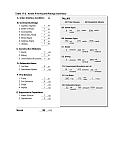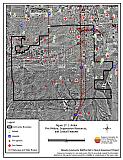17.0 Arden
17.1 Risk and Hazard Assessment
Arden is located southwest of Las Vegas in southeastern Clark County. The town is situated in the Las Vegas Valley and surrounded by Mojave Desert scrub vegetation. The community hazard assessment resulted in classifying Arden in the Low Hazard category (30 points). This low score is attributed primarily to the sparse vegetation surrounding the community, relatively flat terrain, and the fire safe construction of many of the structures in the interface area. A summary of the conditions that contributed to the hazard rating for Arden is included in Table 17-3 at the end of this section. The Arden community boundary is shown in Figure 17-1.
17.1.1 Community Design
The wildland-urban interface surrounding Arden is an occluded condition. Structures within the community abut an island of wildland fuels (open space managed by the BLM). There is a clear line of demarcation between expanses of wildland fuels and private property along roads, fence lines, and property boundaries. Two-thirds of the homes were on lot sizes of less than one acre; the rest were on parcels of one to ten acres in size.
Access: Major roads near Arden include State Route 160 and Interstate 15. Within Arden, roads are typically paved, greater than 24 feet wide, and allow adequate room for fire suppression equipment to maneuver. All roads have less than a five percent gradient.
Signage: Street signs are present and visible along fifty percent of the streets. Residential addresses are visible on about one-third of the homes surveyed.
Utilities: All of the electrical utilities were underground and therefore do not pose an ignition risk.
17.1.2 Construction Materials
All of the homes observed in the interface area are built with fire resistant siding materials. Only five percent of the homes assessed have unenclosed balconies, porches, decks or other architectural features that create drafts and provide places where sparks and embers can be trapped, smolder, ignite, and rapidly spread fire to the home. All homes had fire resistant roofing materials such as composition, metal, or tile.
17.1.3 Defensible Space
Ninety-three percent of the homes had landscaping that meets the minimum requirement for defensible space to reduce the risk of property damage or loss of a home during a wildfire.
17.1.4 Suppression Capabilities
Wildfire Protection Resources
In Arden, Clark County Fire Stations 24 and 65 provide the nearest fire suppression resources for immediate response to a wildland fire call. These stations are primarily equipped to respond to urban fire and emergency situations. Additional county resources would be available upon the Battalion Chief’s request through the Clark County Fire Alarm Office.
| Type of Resource | Amount of Equipment | Fire Department (Resource Location) |
|---|---|---|
| Type 1 Structure Engine Patrol Truck Advanced Life Support (ALS) Rescue Battalion Chief |
3 1 1 1 |
Clark County Rural Fire Stations 24 and 65 (Arden) |
| Source: Steve McClintock, Clark County Fire Rural Coordinator | ||
Mutual aid can be requested from the USFS and the BLM through the Las Vegas Interagency Communications Center. The Nevada Division of Forestry also provides mutual aid dispatched from the Sierra Front Interagency Dispatch Center in Minden, Nevada, which locates the nearest available fire suppression resource according to incident command and computer aided dispatch protocols. It is important to note that these resources can be assigned to other emergency incidents during the fire season.
Water Sources and Infrastructure
Water available for fire suppression in Arden include 500 gpm fire hydrants within 500 feet of structures.
Fire Protection Personnel Qualifications
The firefighters have a minimum of NFPA Firefighter I and II training.
Financial Support
Annual operating funds for the Clark County Fire Department comes from the County General Fund, which is generated through the collection of property taxes.
Community Preparedness
Clark County Fire Department has broad community preparedness and public education programs. The Clark County Emergency Response Plan is updated annually. The Clark County Fire Department reviews development plans to ensure compliance with the 1997 Fire Code.
17.1.5 Factors Affecting Fire Behavior
The terrain around Arden is mostly flat. The vegetative fuel density in the interface area is light. Fuel consists primarily of widely spaced greasewood shrubs one to two feet tall and sparse creosote bushes one to four feet tall. There is some tamarisk in the washes where the plants are generally more robust. The fuel load was estimated at less than one ton per acre and considered a low fuel hazard. The predominant wind is from the south/southwest in the late afternoon.
17.1.6 Fire Behavior Worst-case Scenario
Due to the very sparse fuels, the overall fire danger is very low. The largest accumulation of flammable materials is construction debris and framed houses under construction. The worst-case scenario would be a wind driven fire in the large undeveloped areas that would be pushed into the construction areas. There have been several large construction site fires in the Las Vegas area in the past. A construction site fire could also ignite the surrounding open space areas.
17.1.7 Ignition Risk Assessment
Arden has a low ignition risk rating. There is no significant wildfire history on the public lands surrounding Arden, though there is a history of ignitions in and around the community.
17.2 Risk and Hazard Reduction Recommendations
The risk and hazard reduction recommendations for Arden focus primarily on efforts that can be initiated by community members and public agencies to increase wildland fire safety through the reduction of fuels that pose a hazard. Other recommendations pertain to community coordination and public education efforts that could be undertaken to enhance fire safety in Arden.
17.2.1 Defensible Space Treatments
Defensible space treatments are an essential first line of defense for residential structures. The goal of the treatments is to significantly reduce or remove flammable vegetation within a prescribed distance from structures. (Refer to Appendix E for the recommended defensible space area). Defensible space reduces the fire intensity and improves firefighter and homeowner chances for successfully defending a structure against oncoming wildfire.
Property Owners
- Remove flammable vegetation and debris from within the defensible space area.
- Immediately dispose of cleared vegetation when implementing defensible space treatments. This material dries quickly and poses a fire risk if left on site.
- Maintain this defensible space as needed to keep the space lean, clean, and green.
- Maintain the areas underneath decks, porches, etc. free of weeds and other flammable debris to prevent sparks lodging, smoldering, and spreading fire to the home.
- Clear vegetation and combustible materials around propane tanks for a minimum of ten feet.
- Assure that residential addresses are visible from the road. Address characters should be at least four inches high, reflective, and posted where the road and driveway meet. Improving visibility of addresses will make it easier for those unfamiliar with the area to navigate an area during a wildland fire.
17.2.2 Community Coordination
The following community development coordination recommendations are made to ensure that future residential growth in the urban-wildland interface is fire safe.
Clark County
- Facilitate cooperation between the Assessor’s Office and the Roads Department to ensure that all roads in new residential developments are named, mapped, and identified with GPS locations.
- Require all future development in the county to meet or exceed the 2000 International Fire Codes and defensible space requirements. Special attention should be paid to fire-safe construction specifications, road construction, water supply, fire service needs (such as turnaround space), and the establishment of defensible space requirements before construction begins.
17.2.3 Fire Suppression Resources
Clark County Fire Department
- Provide all firefighters with basic wildland fire training and equipment as described in the National Wildfire Coordinating Group (NWCG) Wildland and Prescribed Fire Qualification System Guide 310-1. Provide annual wildland firefighting refresher training and fire shelter training. See section 4.2 for further discussion on this recommendation.
17.3 Summary of Recommendations
| Involved Party | Recommended Treatment |
Recommendation Description |
|---|---|---|
| Property Owners |
Defensible Space | Continue to maintain defensible space as needed to keep the space lean, clean, and green. Assure that residential addresses are visible from the road. |
| Clark County | Community Coordination | Facilitate cooperation between the Assessor’s Office and the Roads Department to ensure that all roads in new residential developments are named, mapped, and identified with GPS locations. Require that all future development to meet or exceed the 2000 International Fire Codes and the defensible space recommendations in Appendix E. |
| Clark County Fire Department | Fire Suppression Resources | Provide all firefighters with basic wildland fire training and equipment and annual refresher courses. |
Table 17-3. Arden Wildfire Hazard Rating Summary |
 |
Figure 17-1 Arden Fire History, Suppression Resources, and Critical Features |
 |
